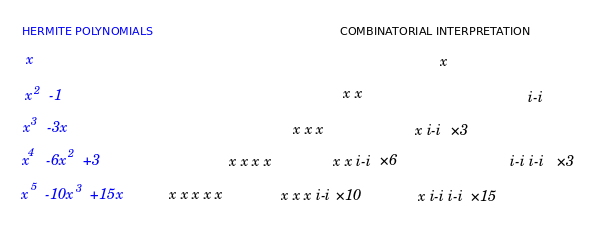Study Groups
Featured Investigations
- How do triangle centers manifest a language?
- Does Bott periodicity model divisions of everything?
- How do economists figure things out?
- How to express Active Inference in Wondrous Wisdom?
Featured Projects
Contact
- Andrius Kulikauskas
- m a t h 4 w i s d o m @
- g m a i l . c o m
- +370 607 27 665
- Eičiūnų km, Alytaus raj, Lithuania
Thank you, Participants!
Thank you, Veterans!
- Jon and Yoshimi Brett
- Dave Gray
- Francis Atta Howard
- Jinan KB
- Christer Nylander
Thank you, Commoners!
- Free software
- Open access content
- Expert social networks
- Patreon supporters
- Jere Northrop
- Daniel Friedman
- John Harland
- Bill Pahl
- Anonymous supporters!
- Support through Patreon!
Wick's theorem
 Wick's theorem provides the combinatorics to express an arbitrary product of creation and annihilation operators in terms of contractions (lines linking operators) and in terms of normal order (whereby all of the creation operators are subsequent (to the left) of all of the annihilation operators).
Wick's theorem provides the combinatorics to express an arbitrary product of creation and annihilation operators in terms of contractions (lines linking operators) and in terms of normal order (whereby all of the creation operators are subsequent (to the left) of all of the annihilation operators).
The combinatorics of Wick's theorem is basically the same as the combinatorics of the Hermite polynomials.
Several ideas come to mind.
- Momentum is expressed by a pair of creation and annihilation operators. We can think of momentum as indicating that a particle disappears and then reappears.
- In the case of fermions, we include a factor of {$i^2=-1$}. Presumably this is because an existing particle disappeared in one location and reappeared in another location. Apparently, this inverts the understanding of energy. Whereas if it appeared and disappeared then that has no bearing.
- In the case of bosons, an existing particle may disappear in one location but reappear in the same location. This has no bearing on energy. The factor is {$1$}.
- In either case, the space is not free but rather something is happening there. Thus it does not incur the cost of free space which is given by the variable {$x$}.
- The operators that are neither creation nor annihilation operators are unpaired saplings. They each get weight {$x$} because they represent cells of free space. An observer carves out that free space.
Questions
- Do the Charlier polynomials express the creation and annihilation operators for bosons?
- Do Feynman diagrams express Zeng saplings?


